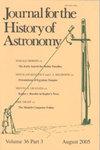主持会议的天文学家
IF 0.3
3区 哲学
Q3 HISTORY & PHILOSOPHY OF SCIENCE
引用次数: 0
摘要
从他在1772年7月3日被正式聘用或1826年柏林天文台的描述和目录等文件中。读者可以按章节翻阅这本书来确定感兴趣的主题。例如,公众对天王星(1781年)和谷神星(1801年)的发现的热情,就像1789年以来大而精确校准的圆的发展一样,导致了1800年子午线圆作为天文台的主要仪器的引入。值得注意的是,波德于1805年从爱德华·特劳顿的伦敦工作室获得的那台两英尺长的仪器并不是子午线圆(尽管波德这样叫它),而是一个高方位角圆(第101、273页)。根据最近对柏林科学院第一位天文学家戈特弗里德·基尔希(Gottfried Kirch)的研究,施韦明澄清了波德和基尔希的女儿克里斯蒂娜之间的关系。波德先后娶了狄奥多拉·基希的两个孙女,她是克里斯蒂娜的继妹(第223页)。因此,克里斯蒂娜·基希和博德之间没有直接的血缘关系。关于“学生和资助”这一章(229-45页)对科学史很有启示。Schwemin发现Bode在不同的关系中支持21个人。他还经常在演讲中遇到旅行者(第246-50页)和听众(第250-68页)。在波德的书信节选中,读到他如何表达自己“对一般社会和政治状况、他的个人圈子和他的通讯员”(第352页),也令人兴奋。schweemin引用了从1779年到1826年的42封信(第352-77页),确定了总共20封信(第324-26页)。姓名索引(第393-407页)使所有的人都能被迅速识别。这本波德传记,有许多按时间顺序排列的来源和文件列表,不是一本普通的传记。它是约翰·埃勒特·博德的生活和工作相当出色和几乎详尽的来源卷,因此激发了新的研究问题。这本书不仅会引起天文学历史学家和对天文学历史感兴趣的俗人的兴趣,而且会引起启蒙运动学者的兴趣,因为1800年左右的天文学家将他们的工作视为“欧洲启蒙运动的重要组成部分”(第13页)。出于这个原因,这本插图丰富的书出现在柏林经典丛书中是非常合适的。Eine Großstadtkultur um 1800。本文章由计算机程序翻译,如有差异,请以英文原文为准。
Astronomers in the chair
from documents such as his official hiring on 3 July 1772 or the 1826 description and inventory of the Berlin Observatory. Readers can page through the volume to identify topics of interest by chapter. For example, public enthusiasm surrounding the discoveries of Uranus (1781) and Ceres (1801) is treated, as is the development, since 1789, of large, precision-calibrated circles that led by 1800 to the introduction of the meridian circle as the primary instrument for astronomical observatories. It should be noted, however, that the two-foot instrument Bode acquired in 1805 from the London workshop of Edward Troughton was not a meridian circle (although Bode called it such) but rather an alt-azimuth circle (pp. 101, 273). Drawing on recent research on Gottfried Kirch, the first astronomer of the Berlin Academy, Schwemin clarifies the relation between Bode and Kirch’s daughter Christina. Bode married, one after the other, two granddaughters of Theodora Kirch, the step-sister of Christina (p. 223). Thus, there were no direct blood ties between Christina Kirch and Bode. The chapter on “Students and Sponsored” (pp. 229–45) is very revealing for history of science. Schwemin finds Bode supporting 21 persons in various relationships. He also frequently met travelers (pp. 246–50) and auditors in his lectures (pp. 250–68). It is also stimulating to read, in the excerpts from Bode’s correspondence, how he expressed himself “on general social and political conditions, his personal circles and his correspondents” (p. 352). Schwemin quotes from 42 letters, dating from 1779 to 1826 (pp. 352–77), identifying a total of 20 correspondents (pp. 324–26). A name index (pp. 393–407) enables all persons to be quickly identified. This Bode biography, with its many chronologically arranged sources and lists of documents, is not a usual biography. It is rather an outstanding and nearly exhaustive source volume for the life and work of Johann Elert Bode and as such stimulates new research questions. This book will interest not only historians of astronomy and laity interested in the history of astronomy but also scholars of the Enlightenment, for astronomers around 1800 saw their work as “an essential part of the European Enlightenment” (p. 13). For this reason it is quite appropriate for this richly illustrated volume to appear in the series Berliner Klassik. Eine Großstadtkultur um 1800.
求助全文
通过发布文献求助,成功后即可免费获取论文全文。
去求助
来源期刊

Journal for the History of Astronomy
地学天文-科学史与科学哲学
CiteScore
0.50
自引率
25.00%
发文量
44
审稿时长
>12 weeks
期刊介绍:
Science History Publications Ltd is an academic publishing company established in 1971 and based in Cambridge, England. We specialize in journals in history of science and in particular history of astronomy.
 求助内容:
求助内容: 应助结果提醒方式:
应助结果提醒方式:


